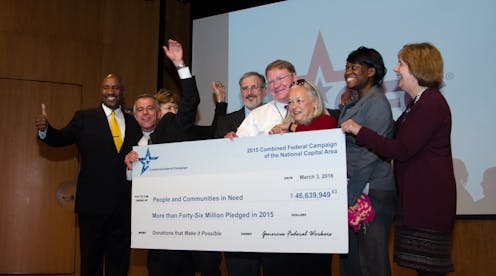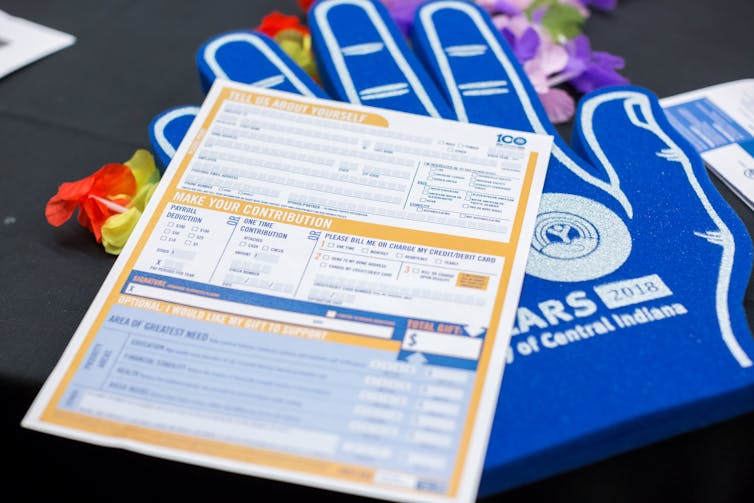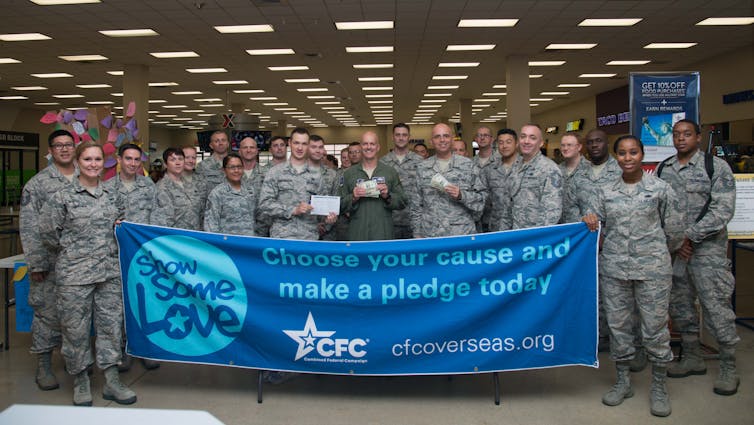What works in workplace giving
By some measures, Americans are giving less to charity through their jobs than they used to. But many companies say that increasing this kind of charity is a priority for them.

Has your boss ever asked you to donate to the United Way? Has a co-worker approached you about giving to the Red Cross? Does your employer encourage giving to nonprofits, or does it match your charitable donations?
Whether they’re responding to emergency requests for disaster relief or making contributions to the local food bank, millions of Americans make charitable contributions through workplace campaigns every year. Despite being commonplace, little is known about these arrangements, and some information suggests that this philanthropic tradition is on the decline.
As scholars who study workplace giving, we wanted to know whether matching programs, employer endorsements and other strategies inspire more employees to support particular causes and what might increase giving overall.

Raising less
Americans give an estimated US$4 billion annually through workplace fundraising drives, according to America’s Charities, a nonprofit that collects these donations and distributes them to its member nonprofits.
Although no one comprehensively tracks workplace giving, some available data suggest it’s losing ground.
The Chronicle of Philanthropy estimated in 2015 that 82 percent of the $3.87 billion the United Way raised the prior year had flowed through workplace campaigns. And the United Way, an international nonprofit that redistributes donations to other organizations, is raising about one-third less money today, adjusted for inflation, than 25 years ago, according to the Chronicle.
Likewise, the Combined Federal Campaign, which helps federal employees based in the U.S. and overseas donate to charity, is experiencing a long-term decline. It raised $167 million in 2016, making it the largest and most successful single-employer workplace campaign. But that was down from $283 million in 2009.
To be sure, this downturn isn’t happening across the board.
Some local United Way campaigns and regional Combined Federal Campaign efforts, such as those in Atlanta, St. Louis and elsewhere, are still growing.
Still a priority
Yet companies like Microsoft say employee philanthropy is a high priority for them.
Some 86 percent of the 120 companies America’s Charities surveyed said their employees expect them to offer ways to get involved in the community, such as workplace giving.
Companies increasingly say they see workplace volunteerism and giving programs as a valuable way to strengthen their relationships with their own employees and local communities.

What employees say
To learn about the dynamics of giving on the job, such as which fundraising strategies work best, we studied and compared employee donation behaviors and perceptions about workplace campaigns.
Our statistical analysis drew from survey data regarding 6,000 people who were asked about their giving at and outside of work. Approximately 1,850 of them told Knowledge Networks, which conducted the nationally representative survey in 2008 on behalf of the United Way, that their employers had organized drives featuring the fundraising strategies we were interested in.
Nearly two out of three of those surveyed whose employers encouraged giving made donations through workplace charitable campaigns. As we explained in the Journal of Nonprofit Management and Leadership, they reported channeling an average of $227 of the $1,340 they gave overall through their workplaces.
We found that people who earned more said they gave more. Those with more education reported making larger donations. The employee’s age didn’t make a difference, and men and women said they gave similar amounts.
These patterns were generally consistent with other research on giving with two exceptions. Studies have found that older people and women are more likely to give.

Which strategies work
We also determined that some employer campaign strategies appear more successful than others.
Employees said they were more motivated to give when employers encouraged it. But employer asks didn’t lead employees to give more money through their workplaces than they would have otherwise.
Employees said they were not motivated to give when they heard about their co-workers’ support for the campaigns. In fact, they felt less inclined to give.
Whether employers announced the names of in-house donors didn’t make a difference in terms of persuading co-workers to give at all or to give more.
When employers matched donations, workers appeared more likely to give and to give more money to a cause. About 8 percent more people said they donated when they worked for companies that offered this benefit, compared to employees of companies that didn’t.
In addition, when employees could choose which nonprofit to support, they said they gave more. Workplace donors with choices reported giving $58 more than those without that flexibility.

Guidance for employers
Based on our research and other scholarship, we believe employers that encourage workplace giving should consider these five guidelines:
- Make a big deal out of the campaign, and make sure people know it is an institutional priority.
- Ensure that employees know about matching programs and find them user-friendly.
- Let employees choose from a range of charities.
- Don’t make a fuss over the people who give on the job. They don’t do it for the attention.
- Refrain from having co-workers ask each other to make donations.
And as end-of-year workplace giving campaigns gear up, employers should know that when they do more to encourage philanthropy, it can make a big difference.
IUPUI doctoral student and Lilly Family School of Philanthropy staff member Jon Bergdoll analyzed survey data for this research.
Genevieve Shaker received funding for this project from the Indiana University Lilly Family School of Philanthropy Research Fund.
Robert Christensen does not work for, consult, own shares in or receive funding from any company or organization that would benefit from this article, and has disclosed no relevant affiliations beyond their academic appointment.
Read These Next
2 superpowers, 1 playbook: Why Chinese and US bureaucrats think and act alike
The men and women tasked with implementing policy are governed by the same incentives and constraints…
Gazing into the mind’s eye with mice – how neuroscientists are seeing human vision more clearly
It was once believed that mice had relatively poor vision. Turns out mice are far from blind – and…
My prescription costs what?! Pharmacists offer tips that could reduce your out-of-pocket drug costs
High prescription drug costs are leaving many patients frustrated and unable to afford their medications.





